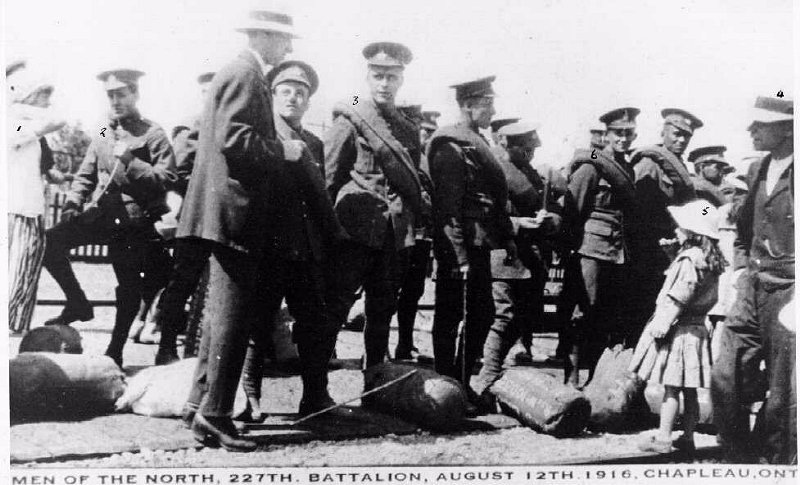
Those known are as follows: (1) Vinnie Barkley (Mrs. Frank Leigh), (2) Frank Leigh (Reverend), (3) Archie McQuaig, (4) Percy Buncombe, (5) Ethel Buncombe, (6) George (Hotcakes) Linklater of White River.
On Saturday, August 12, 1916, the First Chapleau Platoon of the 227th Battalion of the Sudbury, Manitoulin, and Algoma Overseas Battalion paraded from the YMCA building on Lorne Street, down Birch Street, over the tracks, to the railway station. As described in Vincent Crichton�s Pioneering in Northern Ontario, it was �a red letter day.� The Town Band led the way and the whole town turned out to support the �Men O� the North� as they set out to do battle with �the Hun� in fields of northeastern France.
Six officers, fifty-three enlisted men, a bandsman and two buglers marched in full gear to the cheers of the patriotic people of Chapleau. On the train as it pulled away from the station on that sunny Saturday afternoon were three young men who would not return.
Why were the young men of Chapleau marching off to war?
On June 28, 1914, in Sarajevo, a chauffeur made a wrong turn and then stopped his open car to back up. In the back seat of that car were the heir to the throne of Austria-Hungary and his wife. The car stopped right in front of Gavrilo Princeps, a Serbian nationalist, who fired two shots that killed Crown Prince Franz-Ferdinand and his wife, Sophie. Within five weeks, the Great Powers of Europe were at war.
Canada was neither European nor a Power. It was, however, part of the British Empire and, as such, Canada was at war.
Chapleau was at war.
The recruitment drive that rounded up the 62 volunteers who paraded on August 12, 1916, began in April, 1916, when Col. Jones, the Commanding Officer of the 227th Battalion came to Chapleau. Three clergymen, 12 businessmen, and representatives of the outlying communities of Biscotasing, Missanabie, and White River promptly formed the Chapleau Citizens� Recruiting Committee to beat the bushes for suitable men. By 1916, Chapleau (population about 1850) had already seen 120 men leave for the war, but the stalemated Western Front was about to enter the height of its meat-grinding phase and more able bodies were urgently needed.
By May, 1916, a recruiting office was opened for business. As the men signed up, they were billeted at the YMCA. The raw recruits were drilled and lectured by day, all the while being fattened up by baking lovingly prepared by the ladies of Chapleau to supplement the fare found in the YMCA dining-room.
In the first weeks of the recruitment drive, the Chapleau Headlight was not satisfied with the numbers of volunteers and sternly urged the women-folk of Chapleau to pressure their husbands, brothers, sweethearts, and sons to join the colours.
Perhaps roused by the clarion calls of the Headlight�s editorials, perhaps inspired by sermons, perhaps yielding to the emotional blackmail of their mothers, sisters, wives and/or girlfriends, perhaps caught up in the patriotic fervor of the times, perhaps looking for excitement of a kind not found in the wilds of northern Ontario �for whatever reason or combination of reasons�thirty-two men signed up by May 16 and the fiftieth recruit joined the Chapleau Platoon on June 15, 1916.
The 227th Battalion, including the First Chapleau Platoon, did not immediately go to the battlefields of France. It went to Camp Borden and Hamilton for more training before finally sailing for England in March, 1917. By September of that year, the warriors from Chapleau were in France.
Just 14 months later, on November 11, 1918, the madness in Europe ended.
Read the names on the Chapleau cenotaph. Among those who were killed in the Great War, 1914-1918, were Percy Hall, Lorne W. Nicholson, and J. Redbreast, three of the sixty-two men who had smartly marched down Birch Street with the rest of the First Chapleau Platoon on August 12, 1916.
Then, the Town Band had played. The crowd had cheered. Flags had waved.
Now, every November 11, in a brief ceremony at the cenotaph, a bugle plays, people who never knew the war-dead stand silent, and flags touch the ground.
(Written by George Evans, largely based on material found in the book, Pioneering in Northern Ontario by Vince Crichton.)